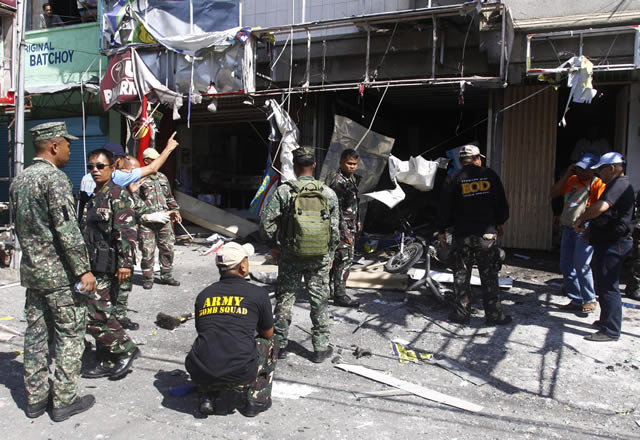
Armed Forces of the Philippines investigators inspect the site of a bomb blast in Cotabato City, southern Philippines August 2, 2011. Suspected Muslim militants believed to be associated with the Jemaah Islamiyah group bombed a gun store in Cotabato City, killing two people and injuring nine others on the second day of Islam's holy month of Ramadan, the military said.
According to press reports, fighting between the Armed Forces of the Philippines (AFP) and the al-Qaeda linked terrorist unit known as the Abu Sayyaf Group (ASG) has erupted in the last few weeks.
In response to a spate of deadly attacks in recent weeks by various insurgent groups, some of which harbor ASG militants, the AFP has launched an extensive operation against the terrorist group on Sulu island involving both air strikes and ground assaults.
Their primary target is the ASG leader Umbra Jumdail, also known as Dr. Abu Pula. This notorious terrorist has committed dozens of atrocities primarily in the Basilan area of the Autonomous Region in Muslim Mindanao province, including bombing military convoys, kidnapping civilians for ransom, and publicly beheading captured soldiers.
Two Jemaah Islamiyah (JI) leaders, the Malaysian Marwan and the Singaporean Mauwiyah, are currently on the run with Dr. Abu. JI is al-Qaeda’s arm in Southeast Asia that is responsible for several attacks in Indonesia—among them the 2002 Bali nightclub bombing. While its Indonesian presence has dimmed in recent years—due chiefly to Detachment 88, an elite counterterrorism unit established, funded, and supported by the U.S and Australia—JI has maintained a strong camaraderie with ASG and remains active in the Philippines.
Marwan, also known as Zulkifli Abdhir, is on the FBI’s Most Wanted Terrorist List. A U.S.-educated Malaysian engineer, Marwan serves as the leader of the Kumpulun Mujahidin Malaysia terrorist group and ASG’s top trainer in bombmaking. He was a close associate to Umar Patek, a JI leader arrested in Abbottabad, the same city in which Osama bin Laden was killed.
Unfortunately, the most recent assaults by the Philippines have failed to capture or kill these top leaders. However, the precision of the strikes, the high level of military integration, and the efficiency of the operation are a testament to the expanding capabilities of the U.S.-trained AFP operators.
Most people may not be aware of this, but the U.S. military maintains boots on the ground in the Philippines—an elite unit of some 600 non-combat, counterinsurgency specialists known as the Joint Special Operations Task Force-Philippines (JSOTF-P). Headquartered and operating within Mindanao and comprised of Army Special Forces and Navy SEALs, this unit’s primary mission has been to train and develop the AFP’s counterinsurgency and counterterrorism capabilities.
This unit is largely responsible for the resounding success in the fight against ASG. The terrorist organization has been on the run and confined to small-scale attacks since 2007, when U.S.-trained Philippine forces largely decimated its leadership. Although ASG has resurfaced in recent years, due in large part to a quasi-alliance with certain Philippine insurgent groups, the Philippine military is infinitely better equipped to deal with them, thanks to America’s support.
Yet the U.S. must not become complacent in its support for counterterrorism operations in Southeast Asia. These terrorist groups know no borders. JI terrorist Umar Patek, who was arrested in Pakistan in January 2011, was an Indonesian trained in Afghanistan and a fugitive in the Philippines. It was, in fact, a plot uncovered in Singapore, not Indonesia, that first brought JI to the world’s attention in 2001.
The September 11 hijackers also met to discuss the operation in Kuala Lumpur. In addition, scores of Americans have been wounded and killed in the various JI-linked Indonesian bombings, including the 2002 Bali nightclub attack. And ASG has kidnapped, ransomed, and even executed Americans in the Philippines. Southeast Asian terrorist cells largely maintain only a regional reach, but given the space to operate, they could very well threaten Americans throughout Asia.
To that end, dispatching elite counterterrorism trainers to the region remains one of the most effective bang-for-your-buck measures within the U.S. military’s toolbox for handling this threat. Developing our allies’ capabilities to combat terrorism is a low-cost, high-yield strategy, as it expends fewer resources than doing the task ourselves. As the Defense Department budget falls victim to draconian cuts in the next few years, the military should not slice one penny from JSOTF-P or Detachment 88.
The Philippines remains a key U.S. treaty ally in the region, and while the U.S. should begin a shift toward assisting the Philippines on maritime security and territorial defense, due to the festering dispute and Chinese aggression in the South China Sea, the U.S. Congress, amidst its budget-slashing discussions, should not forget the success of JSOTF-P and the importance of finishing the job against ASG, JI, and other Southeast Asian terrorist organizations.


























